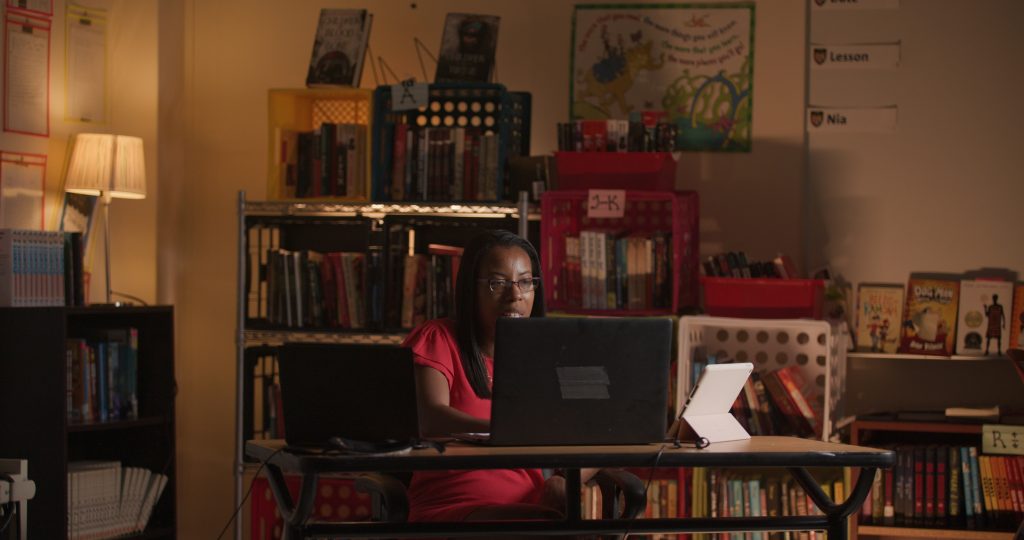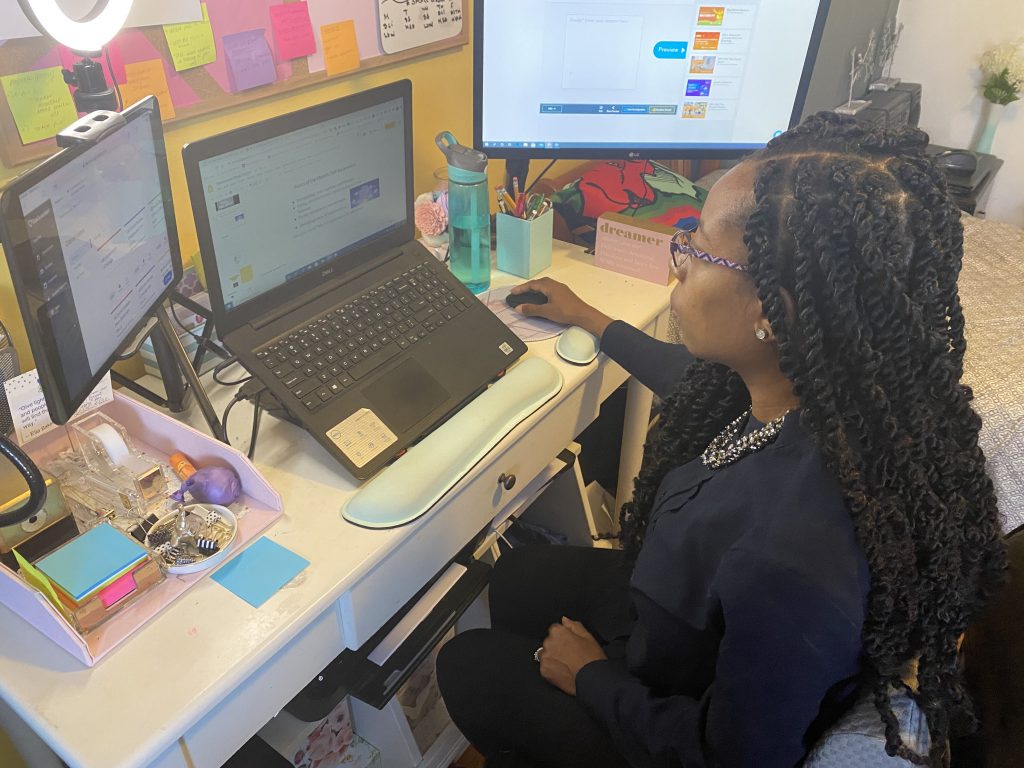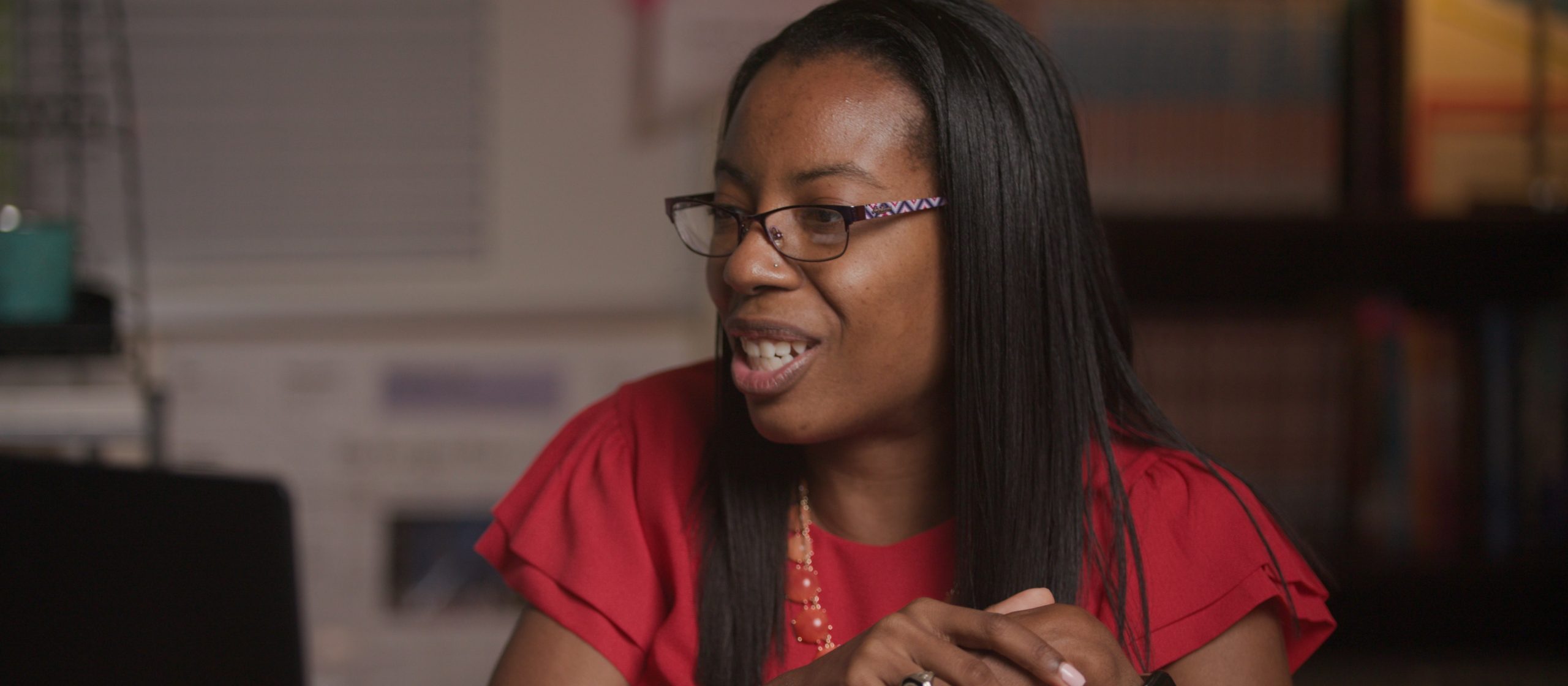
“Why are chemists so great at solving problems?” Theresa Bruce ’09, asks her eighth grade social studies class at KIPP Harmony. Her corny joke elicits no verbal responses but doesn’t go unanswered as students engage with the icebreaker online. “Because they have all the solutions!” Bruce guffaws.
In a year where teaching looks like nothing before, Bruce and other educators are grappling with how to best reach their students, academically and relationally. But the cheesy jokes are nothing new, admits Bruce. “That’s just who I am.” A Sondheim Scholar who majored in political science and social work, Bruce was runner up for the 2020 Baltimore City Teacher of the Year. It’s easy to see why, as her energetic and enthusiastic demeanor comes through clearly, even mediated through the multiple computer windows she uses to instruct her scholars from afar.
But Bruce didn’t set out to be a teacher—she had her sights set on being a hot-shot lawyer. So how to explain her past decade working as a Baltimore City school teacher? She shares this in her own words.
Putting the common good first
When I left high school, I had my mind made up that I was going to be a lawyer. I was going to be the next Johnnie Cochran. Forget if the glove didn’t fit, I was going to have my own catchphrase and it was going to blow up. I was going to be riding in limos with all of the entertainers. Then UMBC got in the way of that fantasy.
Being a part of the Sondheim Public Affairs Scholars program made me realize that I wanted to work toward something greater than myself. My celebrity ideals weren’t putting the common good first—they certainly didn’t push for society in a way that is helpful, meaningful, and beneficial for all. When that switch happened inside me, my mentors at UMBC were instrumental in helping me pursue a new goal, nurturing me, and pushing me along a path that led to public policy.

So how did I end starting my 10th year teaching as a Baltimore City school teacher? After I got my master’s in public policy at the University of Chicago with a focus in K through 12 urban education reform, I realized that I needed to actually be in a teaching role before I could make policy that affected education. Additionally, I believe that every child deserves the opportunity to make choices in their lives. I feel like I got the best public education possible in Baltimore City, and I got it for free. A motivating factor for me is the belief that every child should get what I got.
Lifting up others’ dreams
I’ve always loved school, so UMBC was the perfect fit for me. It was undeniably cool to be smart. So that’s the atmosphere I try to create in my classroom. We all have favorite subjects, and I understand that for some of my students, social studies may not be their favorite. But I want these young people to find some joy when they come into my room—to feel like they can talk with me and connect. I want them to know that I support them in their goals. UMBC taught me the importance of lifting up other people’s dreams.

Looking back on my time as a student, I have so many people I’m grateful to for putting up with me, quite honestly, because I was a headache. I always had an idea. I always wanted to do something. And I wasn’t always listening. Despite that, Dr. Roy Meyers, professor of political science and affiliate professor of public policy, was my biggest champion. Dr. Cheryl Miller, associate professor emerita, public policy and political science, challenged me to think bigger than myself. Dr. Tyson King Meadows, associate professor of political science, taught my very first poli-sci class and never stopped pushing me forward. Delana Gregg, Ph.D. ’19, language, literacy, and culture, a powerhouse in the Academic Success Center, was a constant force in helping me shape my career path while being a sounding board for all of my ideals.
So now, as an educator myself, I ask how I can best push and champion my students. The biggest step I can take—and this doesn’t matter if you’re in a brick-and-mortar building or if you’re online—is to make a relationship. Yes, they’re harder to build virtually, but when young people can relate to you as a person, they’re more apt to try. When you acknowledge them and their efforts, they’re going to try even harder. There’s an old saying I think about often: People don’t care what you know, until they know you care.
Creating community in a virtual classroom
My biggest reward right now is sparking the minds of the next generation. Our young people come to us with so many gifts. They’re talented in ways that might just take a little nudging for them to realize. But I know how many people took time for me, and I want to make my students feel the same. I want them to know I care about their success, beyond their grades. How can I help them discover who they truly are, pursue what matters to them, and be an agent for change?

Part of the way I help them along this path is by putting books in front of them—all the time. There are over 700 books in my classroom that I’ve amassed, partly through donations via the Donors Choose platform and partly by spending my own money. Quarterly, I host a Starbooks session for my students within my classroom, usually around a theme, like non-fiction texts or graphic novels. It gives young people a chance to sample books and see what they might enjoy. Slowly but surely, I’ve been seeing an increase in my scholars’ excitement about reading books and checking them out of my classroom.
Now that we’re meeting virtually, it’s been hard to not gather in the classroom I’ve lovingly decorated and filled with books and materials. My scholars and I have created our own community in the classroom, and it’s been interesting in this pandemic to rethink the way community needs to develop. All things considered, I am thankful because even though we’re in the midst of a global virus, I’ve been pushed to rethink the way I engage the students, not only in the work, but how to grow relationships with them as well. So we’re creating a new classroom, a new virtual one. It may not be as big or as colorful, but it’s got great potential.
*****
Header image, by Corey Jennings ’10. All other photos courtesy of Theresa Bruce, unless noted.
Tags: Baltimore City Schools, CAHSS, Fall 2020, Political Science, social work, Videos, web extra

